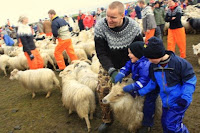 Our first event was a presentation by the largest energy producer in Iceland. We were greeted with coffee, cookies, crescents, and pound cake. We learned about geothermal and hydro electrical energy production. A major hydroelectric project is in the works in Kárahnjúkar with plans for three additional dams in process. The hydro plants have to go through a rigorous planning/assessment before they are able to be built. They have been very controversial environmentally, although Iceland has done very well in mitigating the damage they cause. The reservoirs will not fill up with silt until 500 years from now, which is 300 years after the last glacier melts. The reservoir of the dam will not induce any seismic activity since there already is seismic activity in the area. Structures have been built enabling salmon to get upstream past the dam to spawn. They did not even have to relocate any farmers, since the area that would be covered by the reservoirs is not farmable in the first place. The main area of concern that was brought up in the presentation is that the dams and reservoirs are not aesthetically pleasing. The dams also greatly reduce wat
Our first event was a presentation by the largest energy producer in Iceland. We were greeted with coffee, cookies, crescents, and pound cake. We learned about geothermal and hydro electrical energy production. A major hydroelectric project is in the works in Kárahnjúkar with plans for three additional dams in process. The hydro plants have to go through a rigorous planning/assessment before they are able to be built. They have been very controversial environmentally, although Iceland has done very well in mitigating the damage they cause. The reservoirs will not fill up with silt until 500 years from now, which is 300 years after the last glacier melts. The reservoir of the dam will not induce any seismic activity since there already is seismic activity in the area. Structures have been built enabling salmon to get upstream past the dam to spawn. They did not even have to relocate any farmers, since the area that would be covered by the reservoirs is not farmable in the first place. The main area of concern that was brought up in the presentation is that the dams and reservoirs are not aesthetically pleasing. The dams also greatly reduce wat er flow downstream.
er flow downstream.After the presentation, we ate lunch at a seafood restaurant. The meal was delicious. Lobster soup, minke whale, halibut, monk fish, scallops; it was all amazing. I even enjoyed the experience of eating the cured shark, although the meat itself was definitely an acquired taste. This type of shark does not have any kidneys, so basically, the meat was so rich with ammonia, it smelled like toilet-bowl cleaner. It is a rare delicacy here in Iceland, rich with tradition, and we survived it! The whale was my favorite. It was so rich and juicy. I also greatly enjoyed the halibut and monk fish. While we enjoyed the local delicacies, we listened to a presentation by the biologist Thor Asgeirsson. He works with the Icelandic Ministry of Fisheries, and gave us some information on the history of the Icelandic fishing industry and how it is currentl
 y regulated.
y regulated.Next we were off for a guided tour through the National Museum. We saw artifacts from the settlement period such as swords, axe heads, burial sites, tools, and everyday utensils. We moved further to the present, and saw exhibits on the Catholic and then Protestant control of Iceland, then fishing boats, clothing, wood carvings, and objects of everyday life. After the museum we had the privilege of visiting a live archeological dig near the city center. There they were uncovering the foundation of an old house. One of the most special moments of the day is when the head archeologist at the dig showed us the oldest known artifact in Iceland. It was an anvil used in blacksmithing. It was powerful to think that centuries ago, a Viking would have been standing right where we were today, using the same tool that was in front of us now. How amazing!

After some free time to roam the city by ourselves, we had dinner at a nice restaurant. The food was amazing, especially the dessert, which was three flavors of ice cream along with the berry sauce; it was delicious. After dinner we were treated with a short talk from a former geologist/meteorologist/ice climber who talked to us about Iceland’s geology. His informative presentation broadened our understanding of the glaciers and volcanoes her in Iceland. Exhausted and happy, we returned to our sea-foam green bus and drove back to Sólheimar.
~Marty
(Photos by Elizabeth-Anne)










